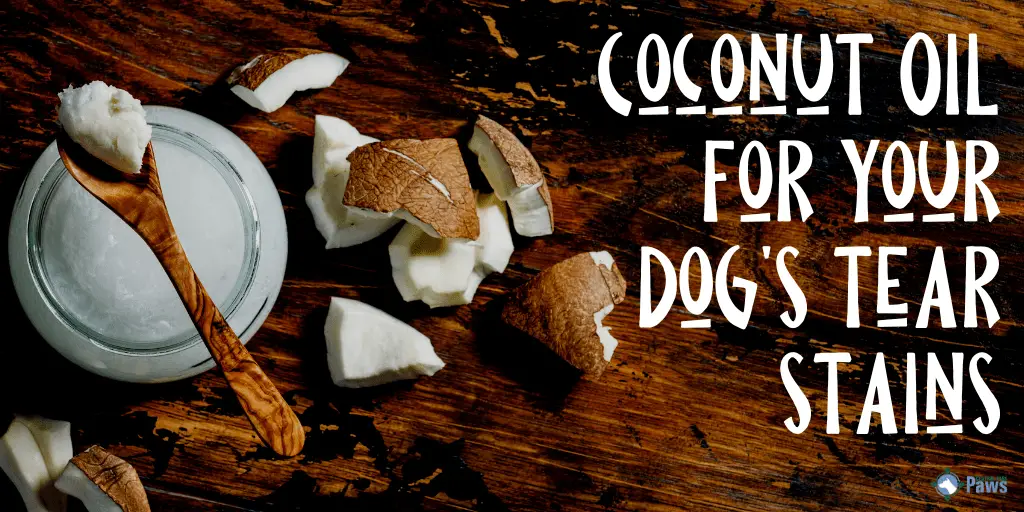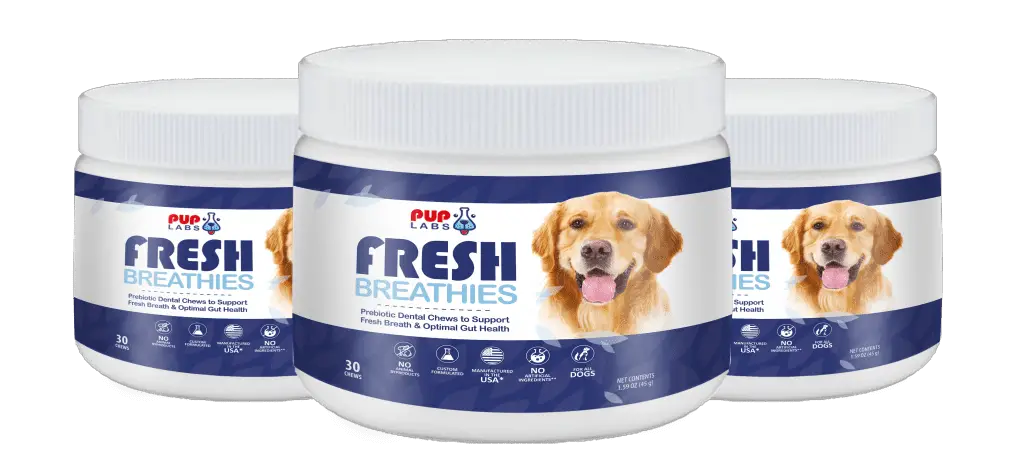It was an unusually warm late February and early March here in Minnesota, which is 99% awesome.
The 1% that isn’t awesome means that allergy season has gotten here early, and Sophie is already feeling its effects.
One of the first signs that her allergies are starting is the tear stains in the corner of her eyes.
I do my best to catch it early so that I can begin treatment right away, ideally avoiding excessive smelly stains on her cute little face.

Though there are various over the counter options and other home remedies, I’ve chosen to use coconut oil.
The reasons I’ve chosen coconut oil over other treatments are:
- It is one of the safest solutions
- It reduces the chances of a fungal or yeast infection
- It works as a preventative
- I always have it on hand
- Economical
Really what isn’t coconut oil good for? I use coconut oil for everything around my house, not just for cooking, but for ailments, illness, and even small cuts and scrapes.
What Causes Tear Stains on Dogs
Sophie’s tear stains are due to allergies, but that’s not the case for all dogs.
Some dogs have tear stains for other reasons like:
- Blocked tear duct
- Allergies, both environmental and food
- Water with excessive mineral content
- Breed (Maltese, Poodles, Shih Tzus, and Pugs in particular[1])
- Infection
- Long hair near or around the eyes
- In-grown hair
- Eye injury

Photo by Frank Pierson (CC BY 2.0)
The condition of when a dog’s eyes tear and don’t correctly drain is called epiphora[2].
If your dog has suddenly developed signs of epiphora, it is best to check with a vet to ensure they don’t have a significant medical condition causing the condition.
However, most often, tear staining is a primarily benign issue.
Ultimately, you will need to resolve the root cause of the epiphora condition to help avoid future issues.
However, some dogs suffer from chronic tearing and will require a maintenance program (or a special diet), like Sophie.
How Coconut Oil Works on Tear Stains
Coconut oil works in two different ways.
First, it can aid in preventing or resolving infections caused by excessive moisture in the area.
Coconut oil is a natural anti-fungal, which helps in preventing and resolving specific yeast and fungal infections[3].
It is critical to note that if your dog has an eye infection, coconut oil will not address this issue, only skin infections caused by the tears.
Second, it acts as a natural barrier to the tears.
Coconut oil is a natural protectant, allowing the tears to roll off the area instead of saturating the surrounding hair. The oil prevents a buildup of moisture and staining under the eye.
Why You Should Use Coconut Oil to Treat Canine Tear Stains
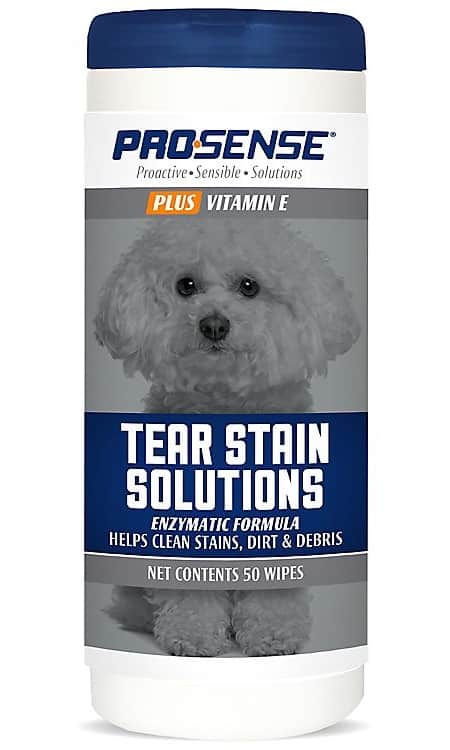
As I mentioned earlier, I like using coconut oil more than over the counter products and even better than some of the home remedies.
I feel coconut oil is often the safer option.
For a long time, people have used hydrogen-peroxide, and though it does whiten the area, it can be quite harmful if it gets into the eyes.
Additionally, some of the common over the counter products for removing tear stains have unfavorable ingredients such as:
- Alcohol
- Artificial preservatives
- Chemical-based whiteners
Though these products are to be used around the eye and not in the eye, accidents do happen.
Plus, the fumes from these products can cause eye irritation even if it doesn’t make direct contact.
Also, there are chews for dogs to prevent tear stains.
I don’t use them since they often contain allergens such as chicken and rice, both of which would make things worse for dogs with food allergies.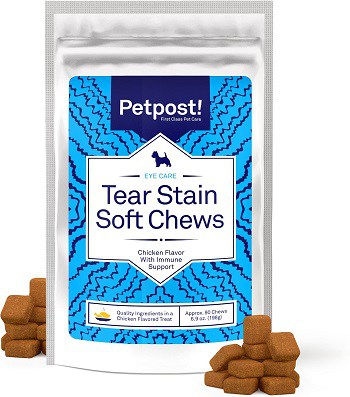
Finally, I feel that the application of coconut oil is quick and easy, and anything that isn’t a fight in our house is always welcome.
I can take care of Sophie’s eyes in under two minutes, and she barely cares when I’m doing it.
So, if you are looking for an easy natural remedy that also works as a preventative, coconut oil is the ideal choice for you.
Why You Shouldn’t Use Coconut Oil to Treat Canine Tear Stains
Though coconut oil is one of the safest remedies, it does still have the potential to cause an allergic reaction.
If your dog has an allergic reaction to the topical use of coconut oil, then it is best to avoid using it, as it will only worsen the situation.
Additionally, you need to use caution when using coconut oil since if you use too much or use it too close to the eye, you can cause tear ducts to become blocked.
Though I love coconut oil for almost all things, it should still be used with caution.
Too much of a good thing can make the situation worse!
If you notice a buildup of oil in the area around the eye, decrease the amount and frequency of application.
Additionally, you will want to gently remove any buildup with a clean, warm (not hot), damp cloth.
Which Coconut Oil Works Best
I always use an organic virgin, cold-pressed coconut oil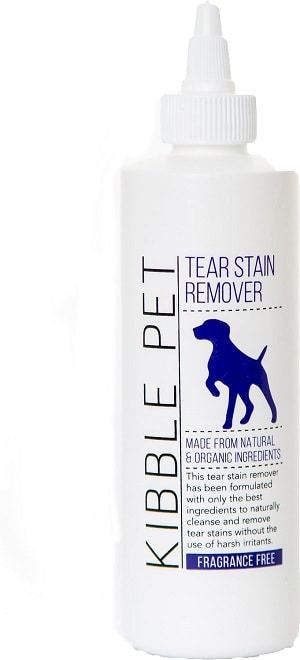
But for those of you who are new to this remedy, you do not need to get organic; it’s just a personal choice on my part.
I would recommend buying cold-pressed coconut oil because this will ensure the integrity of the oil was retained during the extraction process.
There are dog-specific coconut oil-based products to aid with tear staining. I’ve not tried them because plain coconut oil is more economical, and for me, it’s been very effective.
Product Recommendation
How to Use the Oil on Tear Stains
Materials Needed
- Soft Clean Damp Cloth – Avoid items like cotton balls or other items that may have fibers that could get into your dog’s eyes
- Coconut Oil
- Treats
- Blunt Scissors – Optional
Steps
- If you have blunt scissors and can safely trim any of the longer hair around your dog’s eyes, do so, so that it can no longer irritate your pup’s eyes.
- Gently wipe or dab the area clean of debris and excess tears
- Apply a minimal amount of coconut oil to the stained area

Repeat steps 1-3 twice a day until the tear stains are resolved.
To use as preventative for chronic tearing, apply coconut oil once or twice a week, after the stains have been removed.
If your dog starts to show more significant irritation from the coconut oil, cease using immediately and gently clean the area of the oil with a warm, dry clean cloth.
If the area looks inflamed due to an allergic reaction, contact your vet as they may recommend using an over the counter allergy medicine.
Conclusion
Though coconut oil doesn’t have a whitener in it, it will still take care of tear stains.
Though admittedly, it does take a little longer than products with bleach-like ingredients.
If your dog is suffering from epiphora, and you know the root cause, try coconut oil to deal with the staining.
I think both you and your dog will prefer it over chemical-based methods.

